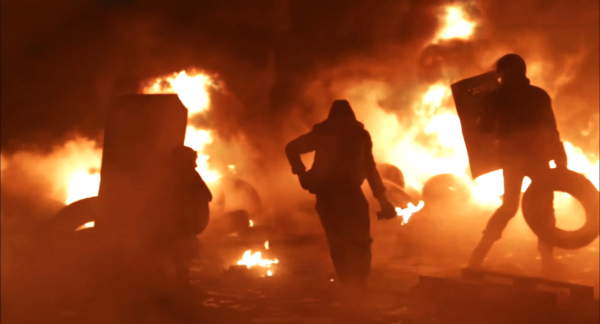This gripping documentary centers on the mass protests, civil wars, invasions, and other sweeping events that overtook Ukraine in recent decades. However, what keeps it from ever being a dry history lesson is the involvement of real-life Ukrainians who witnessed it all and have highly personal stories to share.
The early scenes offer a brief history lesson for those unfamiliar with the region, with narrator Bruce Greenwood recounting Ukraine’s history as a target of conquest by neighboring empires, which in the early 20th century meant Russia and, later, annexation by the Soviet Union. The country declared its independence in 1991, though Russia, under President Vladimir Putin, would attempt to reclaim it, culminating in the controversial election of Viktor Yanukovych to the Ukrainian presidency in 2004.
Believing Yanukovych to be a Kremlin puppet who rose to power through fraud and corruption, large crowds gathered in the Maidan, the main square of Kiev, to demand new elections that year. Though successful, the hope and optimism generated by what would be dubbed the Orange Revolution, named for the colors worn by the protestors, would be overshadowed by the successful election of Yanukovych six years later. A leader in the strongman mold, he cracked down hard on acts of civil unrest, as seen in footage of riot police beating unarmed protestors.
This act of suppression, however, only drew larger crowds to the streets, which in turn led Yanukovych to attempt an even stronger hand. Through interviews with those who took part in the protests at the time, as well as those looking back on them, viewers get an idea of the increasingly hostile conditions for those attempting to shine a light on his regime’s corruption. One of the most shocking accounts is by a journalist named Tetyana, who was terrorized after writing a critical article about the then-interior minister’s personal wealth.
Yet Breaking Point largely avoids being a pity party for Ukraine by painting instead its citizenry as heroic. There is a saying in the film that describes the people as capable of being pushed down a tremendous degree but unstoppable when they finally rise up, which is what Yanukovych’s government learns. As the police gradually switch from using batons to live ammunition on protestors, individuals such as Andriy, the manager of a children’s theatre; Marko, who had been pursuing a career as a rabbi; and others get organized , form militia groups, and start fighting back.
It’s impressive seeing the resistance holding its own through strategies such as burning tires to create smokescreens, though the street-level footage also shows the rapid deterioration of Kiev. At this point, Putin has remained mostly on the sidelines, but as Ukraine’s civil war rages and Yanukovych flees, he finally plays its hand. Without warning, highly trained soldiers wearing uniforms that resemble the Russian army’s, albeit missing the identifying insignia, invade the Ukrainian territory of Crimea and seemed poised to cross Ukraine’s eastern border. At the same time, a pro-Russia separatist movement starts to emerge within the country, committing acts of violence and threatening to further destabilize it.
The film ties these activities back to the Kremlin, in no small way thanks to Putin’s highly unconvincing denials, as well as interviews with the invaders in Crimea, who sneeringly confirm their Russian origins. This section of Breaking Point could fit nicely in a double bill with the recent Netflix documentary Icarus, which also profiled the Russian government’s ruthlessness in furthering its agenda, as well as its tactical brilliance. Directors Mark Jonathan Harris and Oles Sanin show just how confusing the Ukrainian situation likely seemed to outsiders, as Russia effectively obscured the truth by constantly bombarding the West with media “noise.”
Despite such digressions, the film never loses sight of how years of internal and external strife have affected the Ukrainian people. By juxtaposing past and present-day footage of interviewees, we see the degree to which they’ve changed physically and emotionally, in many cases becoming more calloused as a result of personal tragedy. But there are also constant reminders of the camaraderie that cropped up among Ukrainians as they fought back against the siege. For many of them, these events changed their sense of their own identity: where once they may have classified themselves based on ethnic groups, now they view themselves as bound by a common national destiny.
Breaking Point covers a broader time line than Winter on Fire: Ukraine’s Fight for Freedom, which focuses entirely on the resistance against Yanukovych. Yet it is similarly relevant. Both films offer a cautionary tale about of how democracy can be undermined, as well as a sobering but ultimately triumphant portrait of ordinary citizens who refused to surrender their ideals of liberty and justice.

















Leave A Comment